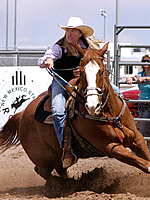
Simon, GeneAboutSimon describes his late start as a rancher, the uniqueness of his current ranch location, his years as a newspaper publisher and editor, and his eight years serving on the Farm & Ranch Heritage Museum Board of Directors.
Abstract
Tape 1, Side A
Simon originally came to New Mexico after the end of World War II, and returned to New Mexico from Pennsylvania in 1973. At that time he was the president and publisher of the Valley Daily News in Tarentum, Penn. Simon sold the newspaper to the Gannett Publishers, who also owned the Ponderosa Highlands Ranch north of Silver City, N.M. Gannett did not want the ranch, so Simon took the ranch in exchange for his minority share of the newspaper. The ranch consisted of 67,000 acres of land on a Forest Service grazing permit. Simon sold the Ponderosa in the mid-1980s and bought three sections of land on Lone Mountain, west of Silver City. He eventually sold this land and purchased 81 acres of land at his current location - Rancho del Rio - near Faywood, N.M. Through the purchase of additional land, he increased the size of the ranch to 7,600 acres, but today he has decreased to approximately 1,000 acres.
Tape 1, Side B
Rancho del Rio has three water wells, an irrigation well, and a well for the house and outbuildings. Most ranchers in the area get water from historic Spanish ditches which specify a day and time to utilize the water. Simon states that he has always had water, although at times the volume or flow of water is less during dry spells. Weather has a definite effect on his ranching operation, and he says that if there is no water then there is no feed. He has not seen any sizeable losses due to weather but has had cattle struck by lightning twice. All of the fences on the ranch are barbed wire. Simon raises the lowest of the four strands higher than usual so that wildlife can get back and forth, so as not to interfere with their natural migration routes. He describes the ranch brand, a typical round of work, and the ranch hands he has used over the years. "Abnormal is normal and normal is abnormal," he says. The same rule applies to both ranching and "newspapering." Cattle prices over the years and the closure of the Deming Livestock Auction are briefly discussed.
Tape 2, Side A
Simon describes the most effective way to handle cattle is to "ease them along." He has never had any problems with predators and says that when ranchers kill or trap coyotes they create a vacuum that more move into. He prefers to leave them be but says that he has had some losses due to man. During the mine strikes in the Silver City area hungry miners would kill a cow and take the best cuts of meat for food. Often hunters mistake black cattle for black bears and accidentally shoot them. He does not permit hunting on the Rancho del Rio because hunters break his fences, leave the gates open, and leave their beer cans and litter behind. Simon recalls only one time when he had serious problems with locoweed and other toxic vegetation, and that was after some strange winter rains. He has never had any problems with either the Forest Service or the Bureau of Land Management and has never gotten involved in any federal or state payment programs. "If you can't hack it yourself, you shouldn't be there," he says.
Tape 2, Side B
Simon believes that "when you mess up nature you do more harm than good." Wolves control the sick, lame, aged, and diseased animals, and cull the weak. It is "nature doing its job," he says. He discusses his childhood memories in Iowa and Ohio and how he got started in the newspaper business.
Simon remembers his mother making homemade soap and root beer. It was his job to stack the bars of soap and to put the caps on the root beer. One day out of the week was always homemade soup day. Minor illnesses were treated at home by his mother or by the doctor who made house calls. He recalls that squab [young pigeons that have not left the nest] was traditionally fed to people who were sick because the meat is easy to digest.
Tape 3, Side A
Simon describes his best memory of growing up as the time when his dad allowed him to shoot a shotgun out the window at midnight on New Years Eve; although the blast sent him flying backwards, it was fun. He recalls his greatest hardship as having to leave his friends in Iowa when he moved to Ohio. He laughs when he remembers when his uncle hooked him up to pull a plow and says that they always had a good garden.
During his college days he worked as a stringer for the Cleveland Plain Dealer newspaper. He wrote the News of Ohio Colleges and Campuses column and also covered college sports for the Berea News. He was able to pay for his college tuition and expenses with no debts. In 1949 he took over as president and publisher of the Valley Daily News after the death of his father-in-law, Charlie Howe. He continued in this capacity until 1976 when the paper was sold to Gannett Publishing.
Tape 3, Side B
Simon compares the way he ran the Valley Daily News with the way that Gannett did after they purchased it. He describes his way as "product quality equals readership and circulation. Readership and circulation equals advertising, and advertising equals money." |

